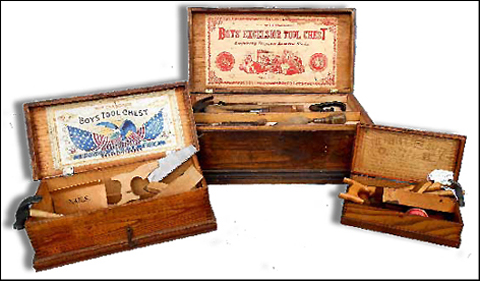By Ken Vliet

In collecting children’s tool chests it is difficult to find them with their original tools. It is a great joy to find a complete or nearly complete tool set because it provides the source for what to look for at toy shows, antique shows, and thank goodness for flea markets. Several of the early tool chests from the 1880s and 1890s will list the child-size tools included on an inside paper label. The larger tool sets would comprise 20 to 30 different tools.
One available source has been the early catalogs of the R. Bliss Manufacturing Company from Paw- tucket, Rhode Island. Besides the children’s tool chests, Bliss was in business from 1835-1935, they made many children’s wood toys and dolls houses. While on vacation, we often try to locate the building sites of early American toy manufacturers. Unfortunately, a visit to Pawtucket ended with photos of 80-year-old row houses on the original company site.
The following are names of some of my labeled children’s tool chests:
1. Boys Tool Chest
2. The Boys Favorite Tool Chest
3. The Boys Columbia Tool Chest
4. The Boys National Tool Chest
5. Boys Union Tool Chest
6. The Boys Star Tool Chest
7. The Model Tool Chest for Boys
8. The Standard Boys Tool Chest
9. Boys Union Tool Chest
10. Superior Youths Tool Chest
I am sure that there must be many more. Ronald S. Barlow’s The Antique Tool Collectors Guide to Value, 1750-1950 (revised. 1991) lists several children’s tool chests and their makers.
The age of the children’s tool chest is best determined by dated catalogs. Another source is the depiction of clothing styles or building activities found on the inside labels. Often the clothing styles can be identified as those worn in the 1880s, 1890s, and early 1900s. One of my children’s tool chests has a label showing a group of boys constructing a mono-wing airplane that hints of the Spirit of St Louis.
During the 1920s and 1930s, the Arcade Toy Company of Freeport, Illinois and the Grey Iron Casting Company of Mount Joy, Pennsylvania, made miniature cast iron tools such as squares, nippers, draw knives, pliers, hatchets, and wrenches. All these miniature cast iron toys were copper or nickel plated and may be added to a children’s tool chest. In the late 1950s and 1960s, the toy manufacturer, Louis Marx and Company of New York City, made miniature die cast woodworking tools.
The choice of material for early children’s tool chests is predominantly American chestnut, worm holes and all. Before the early 1900s, the American chestnut began fading from the landscape around 1904 when a blight imported from Asian chestnuts forced the American chestnut into extinction. In the 1930s, the choice of material changed to poplar which is nowhere near as pretty as American chestnut and the wood often warps. The chestnut tool chests are almost always nice and flat.
The larger children’s tool chests often include a tray for smaller tools. Unfortunately, the trays are often missing. Many of the paper labels found inside the chest are very colorful but are often split down the middle as a result of the wood lid which has either expanded or contracted with age. If attempting to repair these labels be extremely careful as they can be brittle. The labels often include the manufacturer’s name as well as a tool chest number. After World War II, there was a manufacturing shift to metal children’s tool boxes like the popular Handy Andy Toy Tool Set made made by Skil Craft of Chicago, Illinois. Other similar brands were the American Toy Chest for Junior Carpenters, and the Busy Boy Tool Chest. Then in the 1970s, plastic children’s tool sets appear. Unfortunately, the later children’s tools were also plastic. So, guess what? They never rusted.
The toy truck maker Buddy L Toy Company of East Moline, Illinois, made a beautiful, large children’s tool box complete with child-size, high-quality tools by national brand toolmakers like Disston, Stanley, and Miller’s Falls. Fred A. Lundhal, founder of the company, felt that even children should use good tools and even included instructions to take care of the tools with the tool box. Another toy manufacturer, A.C.Gilbert Company of Westville, Connecticut, and of erector set fame, made a very nice tool box. Keep your eyes open. The 1927 Buddy L No. 1 Tool Box came with a Corbin lock marked Buddy L No. The often lost lock and key are worth more than the box to collectors.
